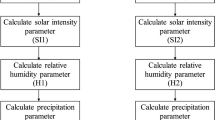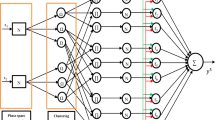Abstract
This study investigates the ability of two different artificial neural network (ANN) models, generalized regression neural networks model (GRNNM) and Kohonen self-organizing feature maps neural networks model (KSOFM), and two different adaptive neural fuzzy inference system (ANFIS) models, ANFIS model with sub-clustering identification (ANFIS-SC) and ANFIS model with grid partitioning identification (ANFIS-GP), for estimating daily dew point temperature. The climatic data that consisted of 8 years of daily records of air temperature, sunshine hours, wind speed, saturation vapor pressure, relative humidity, and dew point temperature from three weather stations, Daego, Pohang, and Ulsan, in South Korea were used in the study. The estimates of ANN and ANFIS models were compared according to the three different statistics, root mean square errors, mean absolute errors, and determination coefficient. Comparison results revealed that the ANFIS-SC, ANFIS-GP, and GRNNM models showed almost the same accuracy and they performed better than the KSOFM model. Results also indicated that the sunshine hours, wind speed, and saturation vapor pressure have little effect on dew point temperature. It was found that the dew point temperature could be successfully estimated by using T mean and R H variables.




Similar content being viewed by others
References
Abdel-Aal RE (2004) Hourly temperature forecasting using abductive networks. Eng Appl Artif Intell 17:543–556
Cakir S, Kadioglu M, Cubukcu N (2012) Multischeme ensemble forecasting of surface temperature using neural network over Turkey. Theor Appl Climatol. doi:10.1007/s00704-012-0703-1
Hsu K, Gupta VH, Gao X, Sorooshian S, Imam B (2002) Self-organizing linear output map (SOLO): an artificial neural network suitable for hydrologic modeling and analysis. Water Resour Res 38(12):1302. doi:10.1029/2001WR000795
Jang JSR (1993) ANFIS: adaptive-network-based fuzzy inference system. IEEE Trans Syst Man Cybern 23(3):665–685
Jang JSR, Sun CT, Mizutani E (1997) Neurofuzzy and soft computing: a computational approach to learning and machine intelligence. Prentice-Hall, Upper Saddle River
Khatibi R (2004) Treating uncertainty in flood forecasting—development, uptake and barriers. In: Proceedings 2nd ACTIF Workshop, Delft, Netherlands. http://209.85.229.132/search?q=cache:pFO5vZJxdQYJ:www.actif-ec.net/Workshop2/abstract/ACTIF_A_S1_05.pdf+Treating+uncertainty+in+flood+forecasting+%E2%80%93+development,+uptake+and+barriers&cd=1&hl=en&ct=clnk&gl=uk
Kim S, Kim HS (2008) Neural networks and genetic algorithm approach for nonlinear evaporation and evapotranspiration modeling. J Hydrol 351(3–4):299–317
Kohonen T (1982) Self-organized formation of topologically correct feature maps. Biol Cybern 43(1):59–69
Kohonen T (1989) Self-organization and associative memory. Springer-Verlag, New York
Kohonen T (1990) The self-organizing map. Proc IEEE 78(9):1464–1480
Kohonen T (2001) Self-organizing maps. Springer-Verlag, New York
Legates DR, McCabe GJ (1999) Evaluating the use of goodness-of-fit measures in hydrologic and hydroclimatic validation. Water Resour Res 35(1):233–241
Lin GF, Chen LH (2005) Time series forecasting by combining the radial basis function network and the self-organizing map. Hydrol Processes 19(10):1925–1937
Lin GF, Chen LH (2006) Identification of homogeneous regions for regional frequency analysis using self-organizing map. J Hydrol 324(1–4):1–9
Lin GF, Wu MC (2007) A SOM-based approach to estimating design hyetographs of ungauged sites. J Hydrol 339(3–4):216–226
Lin GF, Wu MC (2009) A hybrid neural network model for typhoon-rainfall forecasting. J Hydrol 375(3–4):450–458
Mahmood R, Hubbard KG (2005) Assessing bias in evapotranspiration and soil moisture estimates due to the use of modeled solar radiation and dew point temperature data. Agric For Meteorol 130:71–84
Mamdani EH, Assilian S (1975) An experiment in linguistic synthesis with a fuzzy logic controller. Int J Man Mach Stud 7(1):1–13
Principe JC, Euliano NR, Lefebvre WC (2000) Neural and adaptive systems: Fundamentals through simulation. Wiley, New York
Rezaeian-Zadeh M, Zand-Parsa S, Abghari H, Zolghadr M, Singh VP (2012) Hourly air temperature driven using multi-layer perceptron and radial basis function networks in arid and semi-arid regions. Theor Appl Climatol 109:519–528
Sahin M (2012) Modelling of air temperature using remote sensing and artificial neural network in Turkey. Adv Space Res 50(7):973–985
Shank DB, Hoogenboom G, McClendon RW (2008) Dewpoint temperature prediction using artificial neural networks. J Appl Meteorol Climatol 47:1757–1769
Smith BA, McClendon RW, Hoogenboom G (2005) An enhanced artificial neural network for air temperature prediction. Proceedings of World Academy of Science, Engineering and Technology (PWASET) 7:7–12
Smith BA, McClendon RW, Hoogenboom G (2006) Improving air temperature prediction with artificial neural networks. Int J Comput Intell 3(3):179–186
Takagi T, Sugeno M (1985) Fuzzy identification of systems and its application to modeling and control. IEEE Trans Syst Man Cybern 15(1):116–132
Tatli H, Sen Z (1999) A new fuzzy modeling approach for predicting the maximum daily temperature from a time series. Turk J Eng Environ Sci 23:173–180
Tsoukalas LH, Uhrig RE (1997) Fuzzy and neural approaches in engineering. Wiley, New York
Wasserman PD (1993) Advanced methods in neural computing. Van Nostrand Reinhold, New York
Author information
Authors and Affiliations
Corresponding author
Rights and permissions
About this article
Cite this article
Kisi, O., Kim, S. & Shiri, J. Estimation of dew point temperature using neuro-fuzzy and neural network techniques. Theor Appl Climatol 114, 365–373 (2013). https://doi.org/10.1007/s00704-013-0845-9
Received:
Accepted:
Published:
Issue Date:
DOI: https://doi.org/10.1007/s00704-013-0845-9




